A whole house fan is a type of ventilation system that helps to cool your home by drawing in cooler air from the outside and expelling hot air from inside. By doing this, it reduces your reliance on air conditioning, which can save you money on energy bills. In this blog post, you’ll learn precisely how a whole house fan works and acquire invaluable advice on optimizing its use. Thanks for reading!
How Whole House Fans Work
Whole house fans provide your home with a steady supply of fresh, cool air from the outdoors to improve ventilation and comfort. It is installed directly in the ceiling of living spaces, usually between the attic and the first floor. When turned on, it pulls cooler external air into the living space through windows or doors and expels warmer internal air through the attic opening.
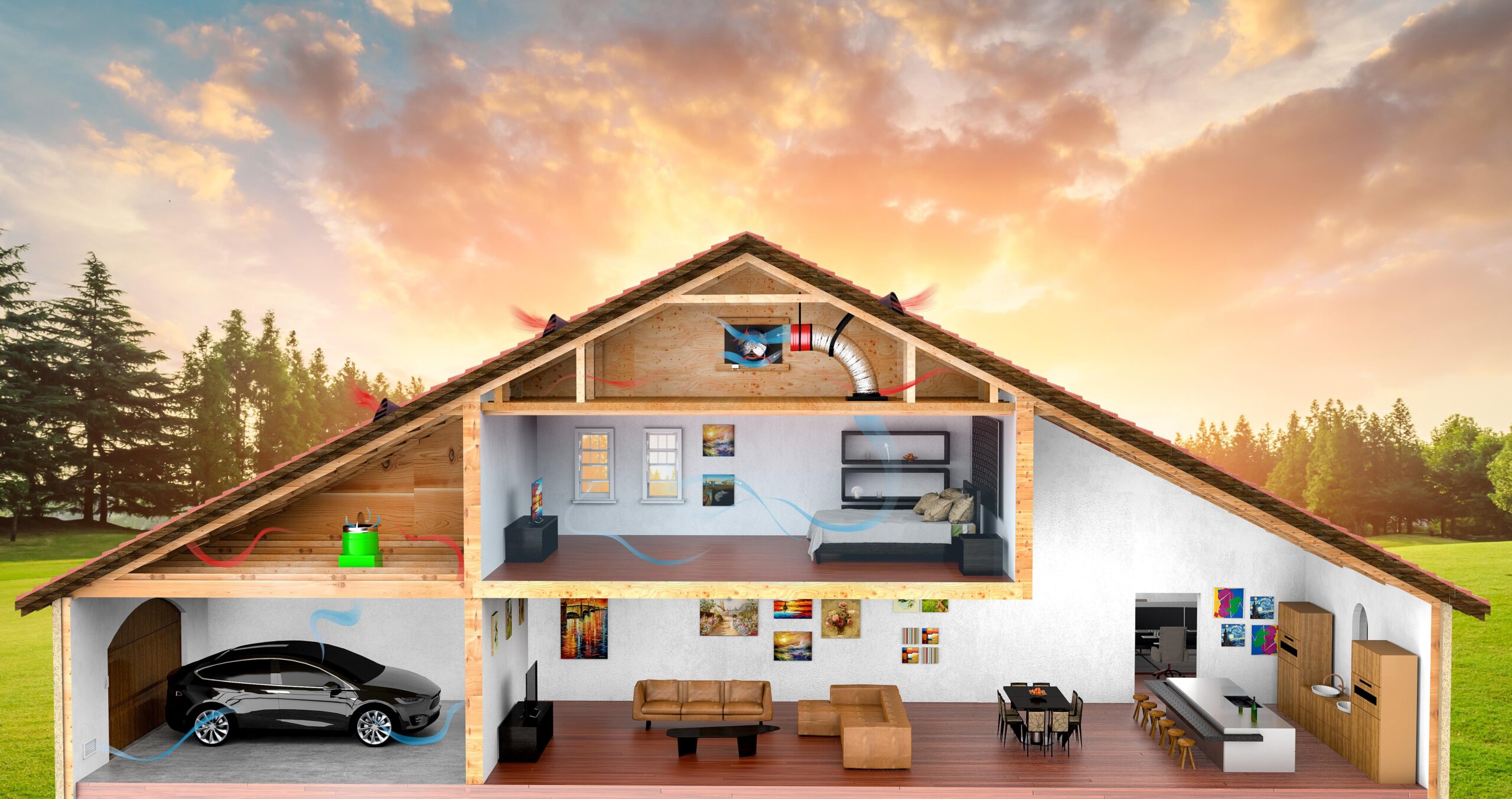
The fan draws in cooler nighttime air from outside and forces out hotter air from inside your home. This exchange of temperatures can help lower indoor temperatures by up to 10-30 degrees Fahrenheit within minutes. In addition, running a whole house fan also removes airborne allergens like dust mites, pet dander, smoke particles, pollen particles, and other irritants that may be trapped in the air.
The most important part of a whole house fan is its motor. The motor pulls in cool air from outside and forces out hot air from inside your home creating an exchange of temperature between the two. It also helps to reduce humidity levels, as it draws dryer air into the space creating a cooler environment.
Most whole house fans have multiple speed settings which allows you to control how much fresh air is brought into the living spaces. Additionally, some fans come with variable-speed settings that allow for even greater control over ventilation rate and noise levels. This makes them great for keeping energy bills low without sacrificing comfort during hot summer months. [1]
Installing and Using a Whole House Fan
Installing a whole house fan is not difficult but it does require some work and time. If you’re comfortable doing basic electrical wiring, installation will be much easier. Start by purchasing the appropriate sized fan for your home that meets local building codes as well as any additional safety requirements. The fan should have pre-drilled holes for mounting into the ceiling joist or rafters and also come with instructions on how to install it.
Once the fan is installed, you can begin using it right away! For proper air circulation, all you have to do is keep your windows open and switch on the toggle situated in either your attic or crawl space. Now just sit back and watch as fresh air fills up each room of your beloved home! When turned on, a whole house fan draws in refreshing outside air through the open windows while pushing out hot attic air. This process helps to keep your entire home cool on hot summer days.
If you want to get extra efficient, consider installing a timer for your whole house fan so that it can turn on automatically when temperatures are high in the home. Additionally, you may also choose to install an insulation cover over the fan during winter months if you live in colder climates to help keep freezing cold air from entering your living space. With these two upgrades, you’ll be able to optimize your fan usage all year round!
Benefits and Drawbacks of Whole House Fans
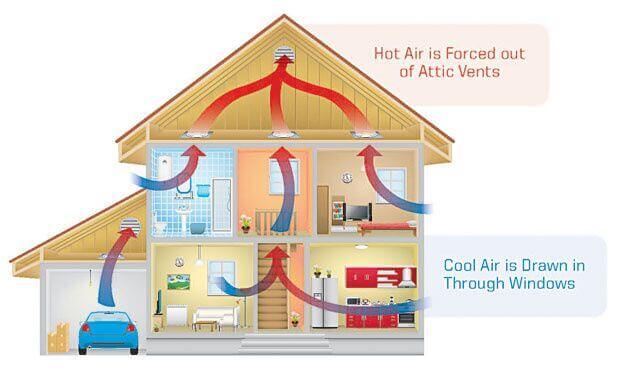
A whole house fan can be an effective way to cool your home, but it’s important to understand the benefits and drawbacks of using this type of cooling system.
Benefits of Whole House Fans:
- Cost effective – a whole house fan uses less energy than air conditioning and is much more affordable;
- Healthy air – as the fan pushes out hot air, it brings in fresh, cooler air from outside which improves indoor air quality;
- Relatively quiet – compared to traditional window fans or portable AC units, a whole house fan operates quietly so you won’t have to worry about annoying background noise while trying to relax at home.
Drawbacks of Whole House Fans:
- Inefficient cooling – although a whole house fan can cool your home quickly, it does not provide consistent cooling throughout the day;
- Needs open windows – in order for a whole house fan to work, you need to have all of your windows open which can let bugs and dirt inside;
- Won’t work on low ceilings – if the ceiling in your home is too low, then a whole house fan may not be effective.
Overall, if you are looking for an affordable way to cool down your home without dealing with loud noises or pesky insects, a whole house fan could be the perfect solution for you. However, make sure that you understand the benefits and drawbacks before investing in this type of system as it may not be right for every household. [2]
Whole House Fan vs Attic Fan
Whole house fans and attic fans are both designed to keep your home cool in the summer months. However, they work differently and may be more suitable for different types of homes.
A whole house fan is installed on a ceiling in the living area of the house and usually runs continuously during hot weather. It draws cooler air from outside into the house until it reaches an even temperature with the interior air. The fan then assists in pushing warm air out of the attic, drawing cooler air in from outside to replace it. This process helps keep your entire home cool without having to use an air conditioner system or other cooling equipment.
Attic fans are typically installed on roof gables near the peak or ridge of the roof. They are usually activated manually by a switch or thermostat and run intermittently to help vent out hot air that has risen into the attic. This helps keep your attic temperature cooler, which prevents your house from becoming too warm during the hottest times of day.
Both whole house fans and attic fans can be effective cooling systems for your home, depending on the size of your house, the layout of its ventilation system, and other factors. Be sure to consult with a professional to determine which type of fan is best for you.
Whole House Fan vs Central Air and Window Units
Whole house fans are an effective and low-cost cooling solution in comparison to central air conditioning or window units. A whole house fan is designed to pull the hot air out of a home, drawing in cooler outside air through windows and other openings. This forces hot air up and out through attic vents creating a whole house breeze that dissipates heat from your living spaces.
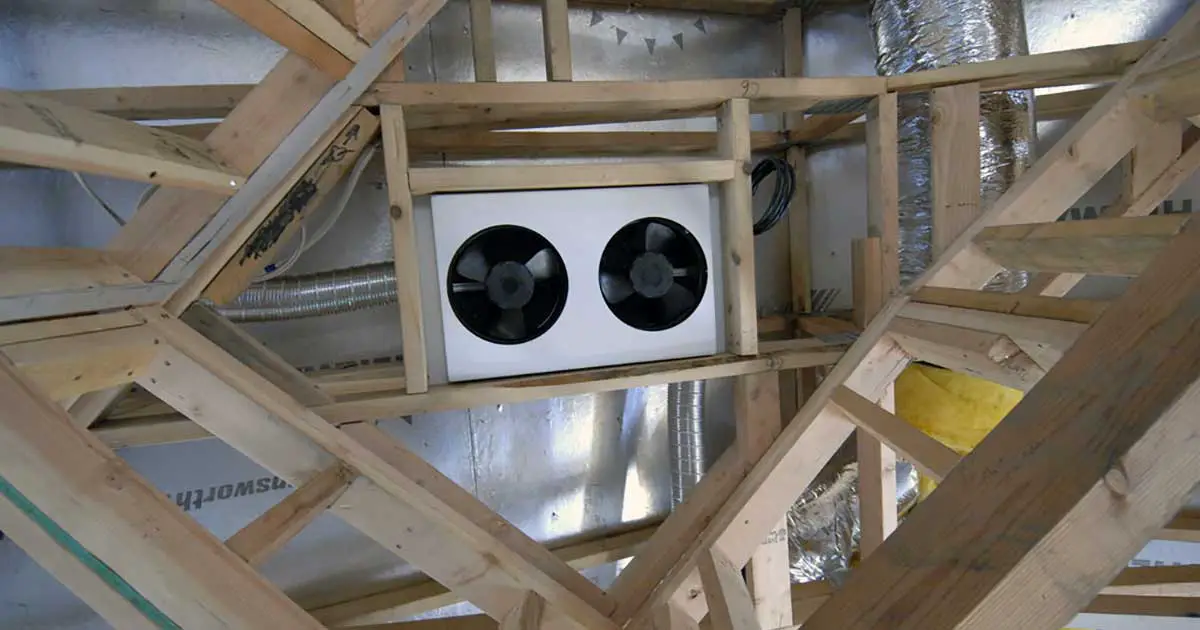
Unlike central air systems that act as a refrigeration system consuming large amounts of energy, whole house fans work with nature instead of against it. With this passive cooling method, you can cool down your entire home while using substantially less energy than traditional AC systems. Additionally, because whole house fans do not create moisture like air conditioners do, they help reduce humidity levels in your home, creating a much more comfortable living environment.
Whole house fans are also substantially less expensive than central air or window units to install and require very little maintenance after installation. With no moving parts and quiet operation, a whole house fan can provide years of reliable cooling at a fraction of the cost of traditional AC solutions.
Ultimately, when deciding between whole house fans and other typical AC systems like central air or window units, it is important to consider your budget, needs, and energy consumption goals before making a decision. Whole house fans offer an affordable, low-energy solution for homes across the US that need some extra cool air during hot summer days. [3]
When Should I Run My Whole House Fan?
A whole house fan can be beneficial year-round depending on where you live, but it’s most effective during spring and summer months when temperatures are warmer. It’s best to run the fan in the early evening or night when outside temperatures have cooled down. The cool air drawn in by the fan will replace hot air trapped inside the home. This not only helps keep your home cooler throughout the day but also more comfortable at night.
When not in use, it’s important to remember to shut off the whole house fan—leaving it running overnight can increase your utility bills without providing any benefit since temperatures tend to be cooler during nighttime hours. Additionally, leaving it running for extended periods of time may lead to condensation and possible water damage due to moisture build up. It is also recommended that you check the insulation levels of your attic before using a whole house fan as proper insulation will help ensure that cool air remains inside the home after being drawn in.
Types of Whole House Fans
A whole house fan is a part of an HVAC system that works to bring fresh air into the home, while also exhausting stale air. There are two primary types of whole house fans: direct drive and belt drive.
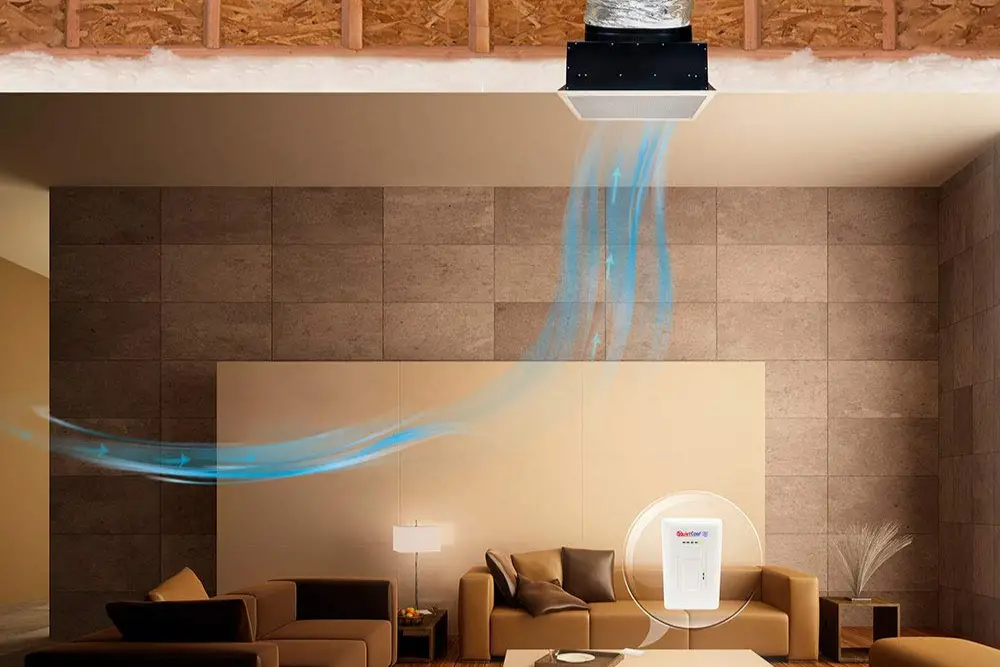
Direct drive fans are typically quieter than their belt-driven counterparts, but they don’t have as much power or cooling capacity. They use a motor that directly powers the fan blades, and they can be mounted on either side of the attic floor or ceiling joists.
Belt driven fans use a motor-to-fan belt system that transfers energy from the motor to the fan blades in order to create more airflow than direct drive fans. These models are usually louder compared to direct drive models, but they have more power and can cool a larger area of the home.
Both types of fans are available in a variety of sizes to accommodate different ceiling heights, and some models also feature variable speed settings or reverse rotation capacities. They can be installed in an attic or other suitable space where they will not interfere with the structure of the home. [5]
FAQ
What are the negatives of a whole house fan?
Whole house fans can be loud, particularly when they are first turned on. If your home is insulated, the fan noise may be louder inside than outside of the house. The fan itself may also cause vibrations throughout your living space. Furthermore, some whole house fans need to be vented outdoors and may require additional installation costs for proper ventilation.
Additionally, if you live in an area with high humidity levels, a whole house fan may not be effective in reducing indoor moisture levels due to heat being pulled from humid air outside into your home.
Finally, if you have allergies or asthma, using a whole house fan could potentially cause discomfort as the air is circulated from outside to inside your home. It’s recommended that those with allergies and asthma consider using an air filtration system with their whole house fan.
Can you run a whole house fan with the windows closed?
It is not recommended to run a whole house fan with the windows closed, as it can cause pressure to build up inside your home. This pressure can make it difficult for the fan to pull air through its vents and could lead to damage over time. Additionally, since you’re relying on the fan itself to circulate fresh air from outside into your living space, having the windows closed will not allow for this exchange of air. For best results, open some windows in each room when using a whole house fan in order to help create an airflow throughout your living space.
Can you run a whole house fan all night?
The answer is yes, you can run a whole house fan all night, but it depends on the individual needs of your home. If you are using the fan to cool down a warm home and need to keep it cooler for longer periods of time, then running the fan overnight is recommended.
However, if you only need to drop the temperature in your home quickly and don’t plan on leaving the fan running throughout the night, then turning it off after an hour or two may be enough.

How long should you leave a whole house fan on?
In most cases, it’s best to leave a whole house fan on for no more than 15-20 minutes. During this time, the fan will pull cool air in through open windows and exhaust hot air out through an attic vent or gable vent. After 15-20 minutes of operation, close all doors and windows to prevent the cool air from escaping. This allows your home to enjoy the full cooling benefits of the whole house fan before long. It is important not to leave a whole house fan running too long so that you don’t waste energy or create too much noise from prolonged use. Additionally, you should be sure that all vents are properly sealed when the unit is not in use, as this will help keep cool air in and hot air out.
Do whole house fans use a lot of electricity?
No, whole house fans typically use very little electricity. Depending on the size and type of system you have installed, a whole house fan can draw as little as 75 watts or up to 750 watts. In comparison, a standard air conditioner typically draws around 1,500-3,000 watts of power. As such, running a whole house fan is an efficient way to cool your home without using large amounts of energy. Ultimately, knowing how long to leave a whole house fan on for optimal cooling benefits will depend on the size and layout of your home as well as the outdoor temperature. However, it’s generally recommended that you keep your whole house fan running for no more than 15-20 minutes at a time in order to maximize cooling efficiency.
Where is the best location for a whole house fan?
The ideal location for a whole house fan is in the center of your home’s highest level, usually an attic or second story. This allows the fan to draw cool air from a variety of sides and prevent hot air from being blown back into living spaces. It’s also important to place the fan near ceiling joists so that it can be properly supported and secured. Additionally, having access to open windows on multiple sides will allow for optimal ventilation when running your whole house fan.
Useful Video: How Does a Whole House Fan Work? | Whole House Fans 101
Conclusion
The efficient and cost-saving operation of a whole house fan is unrivaled in the home cooling market. Not only does it provide relief from the summer heat, but its ability to circulate air through the entire house makes it an all-around great choice for both comfort and health. By utilizing this simple yet powerful technology, homeowners can enjoy cooler temperatures with minimal energy use. With proper installation and maintenance, a whole house fan will bring years of satisfaction and enjoyment to your home.
References
- https://www.energy.gov/energysaver/cooling-whole-house-fan
- https://www.ecotelligenthomes.com/whole-house-fans-keep-or-remove/
- https://oransi.com/blogs/blog/ac-vs-whole-house-fan
- https://www.wholehousefan.com/blogs/wholehousefans/tips-for-running-whole-house-fans
- https://www.bobvila.com/articles/best-whole-house-fan/





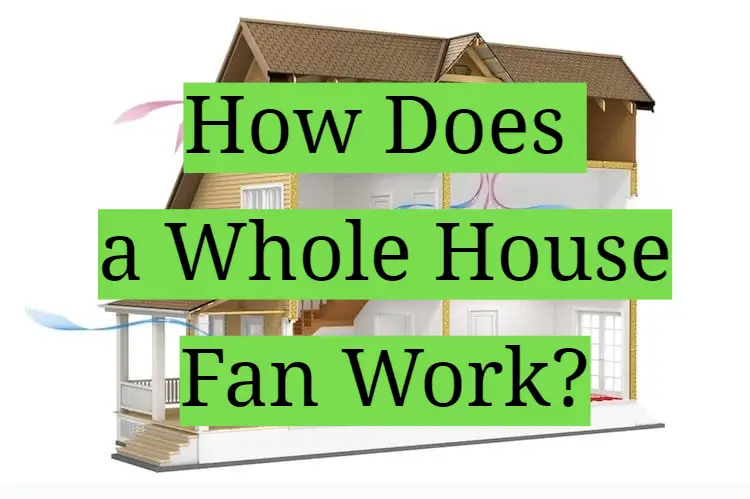





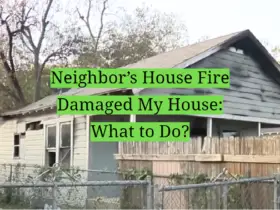


Leave a Reply